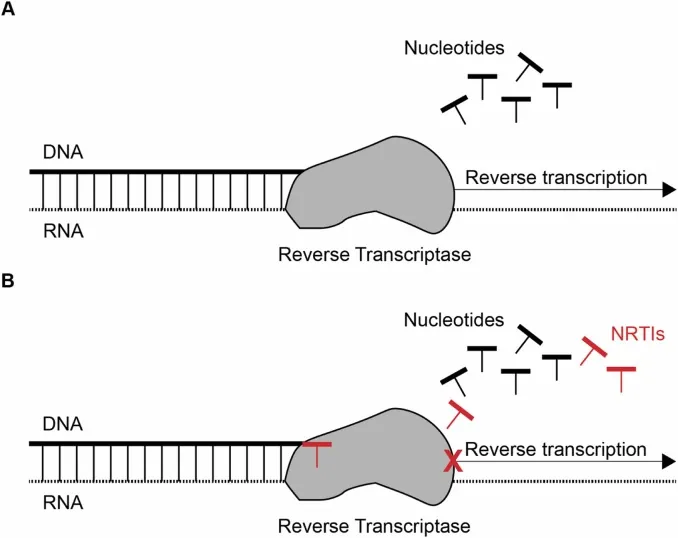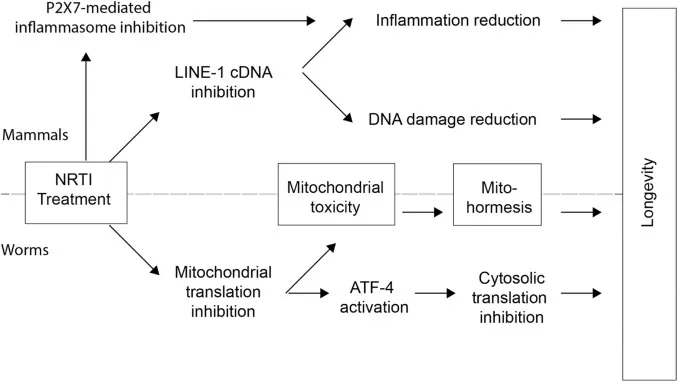Publishing in Ageing Research Reviews, a team of researchers including Vera Gorbunova has described how a class of drugs originally used to treat HIV might be used to affect some of the hallmarks of aging.
Inhibiting DNA changes
DNA transcription, which transfers DNA code into the RNA that cells use to make proteins, can also happen in reverse: RNA can be employed to write DNA in reverse transcription. Nucleoside reverse transcriptase inhibitors (NRTIs) are structurally very similar to the four well-known base nucleotides, A, C, G, and T, that make up DNA code. However, once a reverse transcriptase incorporates an NRTI instead of a real nucleotide, it can no longer continue.

NRTIs have been used in the treatment of HIV, which uses reverse transcription to spread [1]. Other research has found that NRTIs reduce inflammation in model mice that do not produce SIRT6 [2], help to fight a class of inflammatory diseases [3], and increase the lifespan of C.elegans worms [4].

Genomic instability and inflammaging
LINE1 retrotransposons are introduced into the genome through reverse transcription. Because inserting them requires breaking DNA, these L1 elements have been linked to genomic instability [5]. By blocking the reverse transcription that allows them to spread, NRTIs directly inhibit this process.
L1 elements also become active with cellular senescence and aging, causing cellular inflammation [6]. Therefore, it is unsurprising that NRTIs have been also been reported to fight the age-related increase in inflammation known as inflammaging, and some of the particular pathways that they inhibit have been elucidated [3].
This line of inquiry has resulted in several studies that focus on NRTIs’ anti-inflammatory activity, examining their effects on such diseases as macular degeneration. There are even ongoing human clinical trials that are testing the NRTIs emtricitabine and lamivudie against Alzheimer’s disease.
Inhibiting reverse transcription also upregulates ATF-4, which is related to the natural stress response of cells. This is the driving factor behind its effects in C.elegans worms [4], and other lifespan extension treatments, such as rapamycin and caloric restriction, also upregulate ATF-4 [7].
Side effects
Unfortunately, despite these studies showing promise, this interference with biology can come with potentially deadly side effects. NRTIs are an old class of drugs, and many of the initial efforts, such as the original anti-HIV drug AZT, have since been removed from the market or never placed on it. Newer NRTIs, including lamivudine, are not as dangerous but still have severe side effects, such as liver disease and lactic acidosis.
Many of these side effects can be traced back to NRTIs’ effects on mitochondrial DNA, causing mitochondrial dysfunction: another hallmark of aging. In fact, these mitochondrial effects appear to be a key part of the ATF-4 stress response that increases longevity in some animals. Beneficial amounts of stress response are known as hormesis, and this effect has been reported to improve overall health [8].
With both their benefits and side effects in mind, any effort to use NRTIs for anti-aging purposes must first make sure that these drugs are not doing more harm than good. Further work and testing must be done to determine if any treatment that inhibits reverse transcription can improve health and lifespan rather than reducing it.
Literature
[1] Pau, A. K., & George, J. M. (2014). Antiretroviral therapy: current drugs. Infectious Disease Clinics, 28(3), 371-402.
[2] Simon, M., Van Meter, M., Ablaeva, J., Ke, Z., Gonzalez, R. S., Taguchi, T., … & Gorbunova, V. (2019). LINE1 derepression in aged wild-type and SIRT6-deficient mice drives inflammation. Cell metabolism, 29(4), 871-885.
[3] Fowler, B. J., Gelfand, B. D., Kim, Y., Kerur, N., Tarallo, V., Hirano, Y., … & Ambati, J. (2014). Nucleoside reverse transcriptase inhibitors possess intrinsic anti-inflammatory activity. Science, 346(6212), 1000-1003.
[4] McIntyre, R. L., Molenaars, M., Schomakers, B. V., Gao, A. W., Kamble, R., Jongejan, A., … & Janssens, G. E. (2023). Anti-retroviral treatment with zidovudine alters pyrimidine metabolism, reduces translation, and extends healthy longevity via ATF-4. Cell reports, 42(1)
[5] López-Otín, C., Blasco, M. A., Partridge, L., Serrano, M., & Kroemer, G. (2023). Hallmarks of aging: An expanding universe. Cell.
[6] De Cecco, M., Ito, T., Petrashen, A. P., Elias, A. E., Skvir, N. J., Criscione, S. W., … & Sedivy, J. M. (2019). L1 drives IFN in senescent cells and promotes age-associated inflammation. Nature, 566(7742), 73-78.
[7] Li, W., Li, X., & Miller, R. A. (2014). ATF 4 activity: a common feature shared by many kinds of slow-aging mice. Aging cell, 13(6), 1012-1018.
[8] López-Otín, C., & Kroemer, G. (2021). Hallmarks of health. Cell, 184(1), 33-63.









